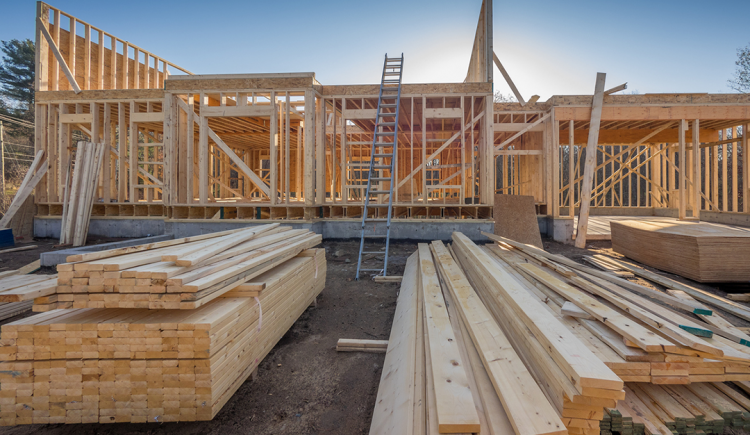The impact of higher building material costs is going to be palpable in real estate as experts say price tags for newly built homes reflect a mix of factors from pandemic-induced to potential inflationary circumstances.
“Costs are definitely higher,” says Robert Dietz, chief economist at the National Association of Home Builders (NAHB). “The best advice to buyers and renters is to be strategic in terms of how you approach the housing market right now.”
Rising material prices and supply chain shortages dropped builder confidence for newly built single-family homes to its lowest level since August 2020, according to the recent reports from NAHB.
Dietz says material costs in aggregate were up at least 20% YoY, but individual prices for different materials have seen triple-digit growth over the past year and half.
“That’s easily adding about $36,000 to the price of a single-family home, and probably adding about $120 to the rent of a typical apartment when those costs are fully phased in,” he says.
Builder Challenges
While builders are doing their best to deal with the issue, sky-high costs of building materials continue to challenge their efforts, leaving some concerned for the future of the housing market.
That’s been the case for Boise-based builder Steve Martinez of Tradewinds General Contracting.
“At some point when the market does stop, pause or cool off, who’s left holding the bag?” Martinez asks. “You’ve got many builders that are either not committing to a contract price with clients, or they are only looking to build spec homes because they don’t know what their costs will be, which takes inventory off the table.”
While every material has gotten more expensive, Martinez admits that softwood lumber has been a more considerable challenge to new construction.
Lumber mills across the country overestimated the decline in housing demand during the pandemic’s early days. As a result, the unexpected surge in demand for building materials amid the 2020 remodeling boom and pandemic relief-induced wealth blindsided companies.
“Unfortunately, they rolled the dice, and they rolled it wrong,” Martinez quips. Housing only exploded after the pandemic hit, specifically states like Idaho where we had a huge influx of out-of-state people moving to get away from the more metro areas.”
While pandemic-induced factors sparked the triple-digit gains, lumber prices have been an issue for builders for the past two or three years due to high tariffs on softwood imported from Canada.
Roughly 30% of the lumber used in U.S. homebuilding comes from Canada, which currently has tariffs at 9%. There is a chance that could double, according to previous announcements from the U.S. Commerce Department.
“Our estimate on the producer price index is for about a 6% gain in 2021, but then some of those cost pressures should ease as we head into 2022,” Dietz says. “The reason for that is that we expect a lot of growth this year—ultimately in additional supply that will help to tame the price growth.”
Builders made a small dent in the considerable deficit contributing to the frenzied for-sale market, according to Danielle Hale, senior economist at realtor.com®.
“Even though we’ve seen a little bit of moderation in the housing market in response to higher prices, the reality is that there is still a lot of unmet demand from homebuyers…trying to meet that shortage is the biggest thing that we can do to keep the housing market moving forward at this time,” Hale says.
Housing starts rose 3.6% from last month overall and 4.2% for single-family homes. Year-over-year starts rose 50%.
According to Hale, challenges rose in single-family homes’ completion rates, which dipped below 1 million for the first time this year.
“Builders can get started, but these materials cost challenges are making it difficult for them to get them finished ultimately,” Hale says.
Price Hikes and Building Struggles
Economists think it’s a bit too soon to tell, but potential inflation increases this year could add to the price growth in the housing market.
“It’s just like a wait-and-see period for inflation,” says National Association of REALTORS® economist Nadia Evangelou. “The Fed already reported that they think this inflation will be temporary…Even though mortgage rates typically rise when inflation increases, this isn’t what is happening right now.”
According to recent projections by the Federal Open Market Committee, economic growth and inflation are rising higher in 2021 than expected.
The median estimate of annual inflation rose from 2.4% to 3.4% in March, while the median estimate of unemployment remained unchanged at 4.5%.
Housing demand will likely remain strong in 2021 and head into 2022, according to Evangelou, who also expects home building to ramp up during the summer. Although inventory is still low, she anticipates roughly 10% more for existing-home sales and 20% more for new single-family home sales.
It’s still uncertain whether the inflation in the housing market will be short or long term. Brokers expect it to fall somewhere in the middle as the economy rebounds and new inventory enters the market.
“We’ve seen higher home prices and dramatic price increases, to the tune of double-digit increases over the last couple of years,” says Mike Pappas, president and CEO of The Keyes Company in Florida.
That could bode well for the real estate market overall, but Papas says buyers will need to watch interest rate increases for a better picture.
“People are asking if it’s transitory or sustainable inflation,” he says. “There is no question that we are seeing short-term . It’s undeniable to say that we haven’t had inflation or price rise in the short term in many sectors.”
 Jordan Grice is RISMedia’s associate online editor. Email him your real estate news ideas to jgrice@rismedia.com.
Jordan Grice is RISMedia’s associate online editor. Email him your real estate news ideas to jgrice@rismedia.com.












